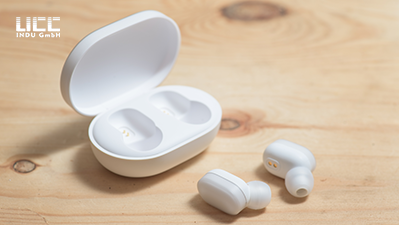 Vietnam
Vietnam
With the rapid growth of the TWS (True Wireless Stereo) headset market, user demand for sound quality and functionality is also rising. Against this backdrop, bone vibration sensors, as a breakthrough technology, are gradually becoming a standard feature of high-end TWS headphones. In this article, UCC will lead readers to an in-depth discussion of the working principle of bone vibration sensors, their application in TWS headphones, and the future development trend.

The working principle of bone vibration sensor
Bone vibration sensors are based on the principle of bone conduction and capture voice signals by detecting the tiny vibrations of the human skull and auricle. Compared with conventional microphones, bone vibration sensors are insensitive to airborne sound waves and therefore can effectively suppress interference from ambient noise. A good quality bone vibration sensor usually has the following characteristics:
A resonant frequency of approximately 4kHz, which matches the frequency range of the human voice.
Signal-to-noise ratio of more than 55dB, ensuring clear capture of the speech signal.
Small size for easy integration into compact TWS headsets
Main applications in TWS headsets
Enhancement of call quality: The bone vibration sensor captures the user's voice signal clearly while effectively suppressing background noise. Combined with traditional microphone signals, this technology significantly improves call clarity, especially in noisy environments.
Improved Voice Interaction: Through bone conduction signals, TWS headset can more accurately determine whether the user is speaking or not, thus improving the accuracy of voice wake-up and interaction and reducing false triggers.
Enables accurate wear detection: Bone vibration sensors can detect whether the headphones are correctly worn on the ear, enabling automatic start and pause playback, which greatly enhances the user experience.
Enhances active noise cancellation: Bone conduction signals can be used as a reference for active noise cancellation algorithms, helping the headphones to more accurately identify and eliminate external noise and provide better noise cancellation.
Support health monitoring function: By analysing the characteristics of bone conduction signals, TWS headphones can even monitor physiological indicators such as heart rate and blood pressure, bringing additional health monitoring functions to users.
Future Development Trends
The continuous advancement of bone vibration sensor technology bodes well for its wider application in TWS headsets. Future developments may include:
Further improvements in signal-to-noise ratio and sensitivity to capture fainter bone conduction signals
Shrinking the size of the sensors and reducing power consumption to make them easier to integrate
Developing innovative applications based on bone conduction signals, such as emotion recognition
Conclusion
Bone vibration sensor technology not only brings new possibilities for TWS headphones, but is also expected to become a standard technology for high-end products. With the maturity of the technology and the depth of its application, it will bring users a smarter and better audio experience and lead the technological innovation of the TWS headset industry.
UCC, as a professional distributor in the field of electronic semiconductors, can provide customers with products suitable for the production of TWS headphones, as well as professional technical support, contact our sales team, we will serve you with heart.
Tuyên bố: trang này cung cấp thông tin chỉ để tham khảo, chúng tôi không đảm bảo tính chính xác và toàn vẹn của thông tin, cũng không chịu trách nhiệm cho bất kỳ thiệt hại hoặc thiệt hại do sử dụng thông tin này.
Đừng bỏ lỡ thông tin cập nhật và khuyến mãi về sản phẩm của chúng tôi. Nhập địa chỉ email của bạn, bấm vào để đăng ký, để cảm hứng và thông tin tiếp tục được gửi đến hộp thư của bạn. Chúng tôi hứa sẽ tôn trọng sự riêng tư của các bạn và không bao giờ gửi thư rác.Liên hệ với chúng tôi: bạn điền vào, đổi lại là dịch vụ sốt sắng của chúng tôi!
2025-06-16
2025-06-10
2025-05-13
2025-05-09
2025-05-07
2025-04-29
2025-04-27
2025-04-23